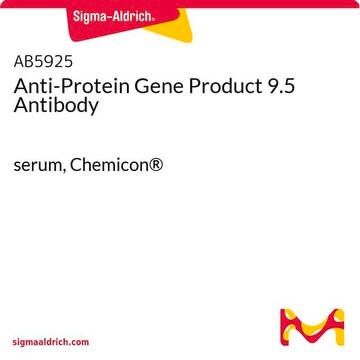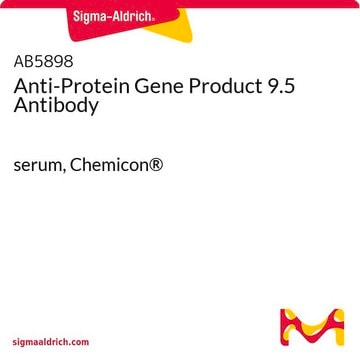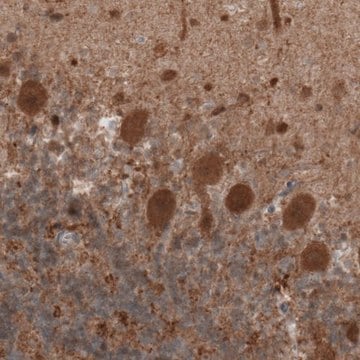AB1761-I
Anti-Protein Gene Product 9.5 Antibody
from rabbit, purified by affinity chromatography
Synonym(s):
Ubiquitin carboxyl-terminal hydrolase isozyme L1, UCH-L1, Neuron cytoplasmic protein 9.5, PGP 9.5, PGP9.5, Ubiquitin thioesterase L1
About This Item
Recommended Products
biological source
rabbit
Quality Level
antibody form
affinity isolated antibody
antibody product type
primary antibodies
clone
polyclonal
purified by
affinity chromatography
species reactivity
human, mouse, rat
species reactivity (predicted by homology)
bovine (based on 100% sequence homology), equine (based on 100% sequence homology), porcine (based on 100% sequence homology)
technique(s)
immunocytochemistry: suitable
immunofluorescence: suitable
immunohistochemistry: suitable (paraffin)
western blot: suitable
NCBI accession no.
UniProt accession no.
shipped in
wet ice
target post-translational modification
unmodified
Gene Information
human ... UCHL1(7345)
General description
Immunogen
Application
Immunohistochemistry Analysis: A 1:1,000 dilution from a representative lot detected Gene Product 9.5 in human cerebellum.
Immunocytochemistry Analysis: A 1:100 dilution from a representative lot detected Gene Product 9.5 in E18 rat cortical cells..
Dylight® is a registered trademark of Thermo Fisher Scientific.
Neuroscience
Developmental Neuroscience
Quality
Western Blotting Analysis: 0.1 µg/mL of this antibody detected Protein Gene Product 9.5 (UCH-L1) in rat brain, human brain, and mouse brain tissue lysate
Target description
Linkage
Physical form
Storage and Stability
Other Notes
Legal Information
Disclaimer
Not finding the right product?
Try our Product Selector Tool.
recommended
Storage Class Code
12 - Non Combustible Liquids
WGK
WGK 1
Flash Point(F)
Not applicable
Flash Point(C)
Not applicable
Certificates of Analysis (COA)
Search for Certificates of Analysis (COA) by entering the products Lot/Batch Number. Lot and Batch Numbers can be found on a product’s label following the words ‘Lot’ or ‘Batch’.
Already Own This Product?
Find documentation for the products that you have recently purchased in the Document Library.
Customers Also Viewed
Our team of scientists has experience in all areas of research including Life Science, Material Science, Chemical Synthesis, Chromatography, Analytical and many others.
Contact Technical Service









